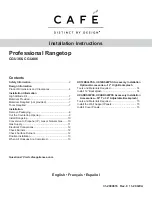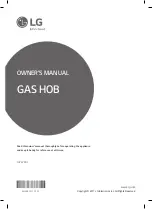
An oven must have forced ventilation to install a hob above it.
Check the dimensions of the oven in the installation manual.
If an extractor fan is installed, you must follow the installation
manual's instructions, always keeping a minimum distance of
650 mm to the hob.
Preparation of the kitchen unit (fig. 1-2)
Make an appropriate size cut in the work surface.
If the hob is electric or mixed (gas and electricity) and there is
no oven below, place a non-flammable separator (e.g. metal or
plywood) 10 mm from the bottom of the hob. This will prevent
access to the base of the hob.If the hob is gas, it is
recommendable to place the separator at the same distance.
On wood work surfaces, varnish the cutting surfaces with a
special glue. This protects them from moisture which could
collect under the work surface.
Installation of appliance
Depending on the model, the adhesive seal may be factory-
fitted. If this is the case, it should not be removed under any
circumstances, since the adhesive seal prevents leaks. If the
seal has not been factory-fitted, apply it to the underside of the
hob. Fig. 3.
Fitting the appliance onto the kitchen unit:
1.
Screw each one of the clips into the position indicated so that
they are free to rotate.
2.
Insert and centre the hob.
Press the sides of the hob until it is supported around its entire
perimeter.
3.
Turn the clips and tighten them fully.
The position of the clips depends on how thick the work
surface is. Fig. 4.
Removal of hob
Turn off the appliance's electricity and gas supply.
Unscrew the clips and proceed in the reverse order to
installation.
Gas connection (fig. 5)
The end of the inlet connection point of the gas hob has a 1/2”
(20.955 mm) thread that allows for:
■
fixed connection.
■
connection using a flexible metal pipe (L min. 1 m -
max. 3 m).
The watertight seal (034308) supplied must be inserted
between the manifold outlet and the gas supply.
You must prevent the pipe from coming into contact with
moving parts of the kitchen unit (for example, a drawer) and
prevent access to any spaces which might become obstructed.
If you need to connect the gas supply horizontally, our Technical
Assistance Service can supply you with an L-tube (code
173018) and a seal (code 034308).
If you need to make a cylindrical connection, replace the factory-
fitted L-tube with the one in the accessory bag. Fig. 5a.
Please remember to insert the seal.
:
Danger of leaks!
If any connection is handled, check the seal.
The manufacturer is not liable for any connection leaking, after
being handled.
Electric connection (fig. 6)
Check that the voltage and power of the appliance are
compatible with the electrical installation.
The hobs are supplied with a power cable with or without a wall
socket plug.
Appliances with plugs must only be connected to sockets that
have earth wires correctly installed.
Provide an omnipolar cut-off switch with a minimum contact
opening of 3 mm (except for plug connections, if the user has
access to it).
This appliance is type “Y”: the supply cable can only be
changed by the Technical Assistance Service and not the user.
The cable type and minimum cross-section must be respected.
Changing the gas type
If the country's regulations allow, this appliance can be adapted
to other types of gas (see specifications plate). The components
required for this are in the transformation kit supplied
(depending on the model) or are available from our Technical
Assistance Service. The following steps should be taken:
A) Changing the nozzles (fig. 7-7a):
1.
Remove the pan supports, burner caps and diffusers.
2.
Change the nozzles using the spanner code 340847 (code
340808 for double-flame burners or triple-flame burners)
provided by our Technical Assistance Service, see table II,
taking special care to ensure that the nozzle does not fall
when it is removed from or fitted to the burner.
Ensure that it is completely tightened in order to guarantee the
seal.
Primary air adjustment is not necessary with these burners.
B) Adjusting the taps
1.
Set the control knobs to minimum.
2.
Remove the control knobs from the taps. Fig. 8.
It has a flexible rubber valve reinforcing ring. Simply press on
this seal with the tip of a screwdriver to allow access to the tap
adjusting screw.
Never remove the valve reinforcing ring.
3.
Adjust the minimum ring setting by turning the by-pass screw
using a flat head screwdriver.
Depending on the gas to which your appliance is going to be
adapted, see table III, carry out the corresponding action:
A: firmly tighten the by-pass screws.
B: loosen the by-pass screws until the gas flow from the
burners is correct: when adjusting the control knob between
maximum and minimum, the burner does not go out, nor is
there a flame backdraught created.
C: the by-pass screws need to be changed by an authorised
engineer.
D: do not touch the by-pass screws.
All
valve reinforcing rings must be in position to ensure
watertightness. These devices are essential for the correct
operation of the appliance as they prevent liquids and dirt from
entering the appliance.
Refit the control knobs.
Never remove the tap spindle (Fig. 9). In the event of a
malfunction, change the whole tap.
Caution!
After finishing, the sticker indicating the new type of gas must be
placed close to the specifications plate.
es
Û
Instrucc iones de m ontaje
Indicaciones de seguridad
Lea las instrucciones del aparato antes de proceder a su
instalación y uso.
Los gráficos representados en estas instrucciones de montaje
son orientativos.
El fabricante queda exento de toda responsabilidad si no se
cumplen las disposiciones de este manual.
Todos los trabajos de instalación, regulación y adaptación a
otros tipos de gas deben ser efectuados por un técnico de
instalación autorizado, respetando toda la normativa y
legislación aplicables, y las prescripciones de las compañías
locales proveedoras de gas y electricidad.
Se recomienda llamar a nuestro Servicio Técnico para la
adaptación a otros tipos de gas.
Antes de cualquier actuación corte la alimentación eléctrica y
de gas del aparato.
Este aparato ha sido diseñado solo para uso doméstico, no
estando permitido su uso comercial o profesional. Este aparato
no puede ser instalado en yates o caravanas. La garantía
únicamente tendrá validez en caso de que se respete el uso
para el que fue diseñado.
Antes de la instalación, debe comprobar que las condiciones
de distribución local (naturaleza y presión del gas) y el reglaje
del aparato son compatibles (ver tabla I). Las condiciones de
reglaje del aparato están inscritas sobre la etiqueta o la placa
de características.
Este aparato solo puede ser instalado en un lugar bien
ventilado, respetando los reglamentos en vigor y las
disposiciones relativas a la ventilación. No debe conectarse el
aparato a un dispositivo de evacuación de los productos de
combustión.
El cable de alimentación debe fijarse al mueble para evitar que
toque partes calientes del horno o placa de cocción.
Los aparatos con alimentación eléctrica deben conectarse a
tierra obligatoriamente.
No manipule el interior del aparato. Si es preciso, llame a
nuestro Servicio Técnico.


































